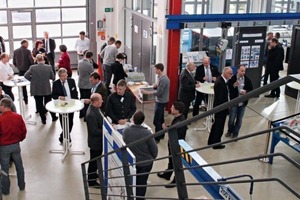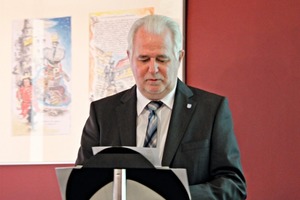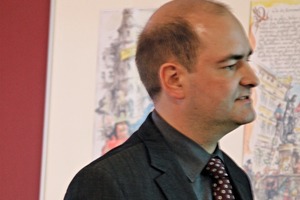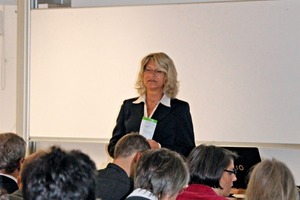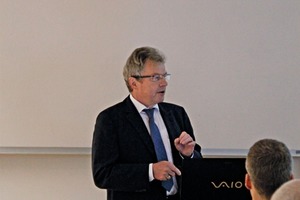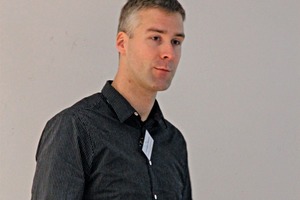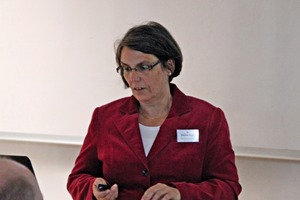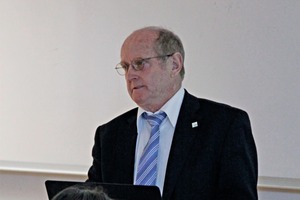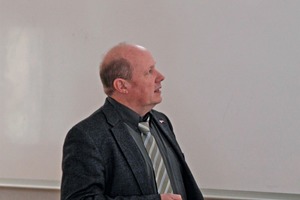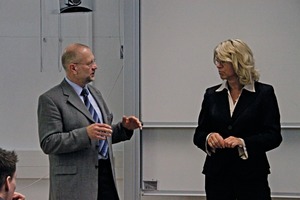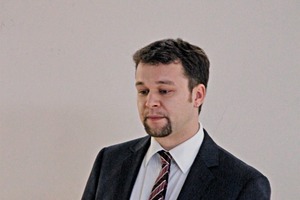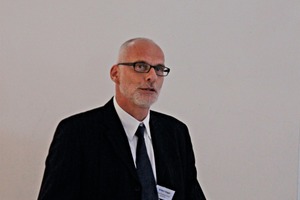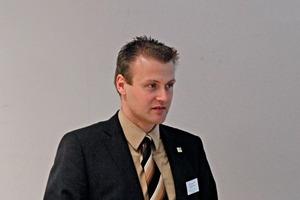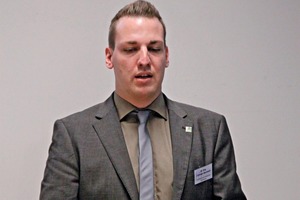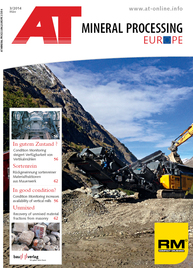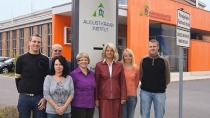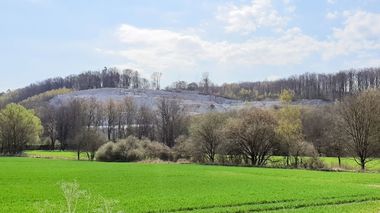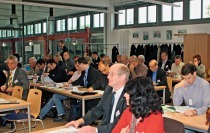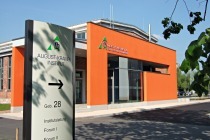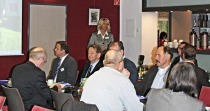Dynamic field of research
On 17 and 18 October 2013, just under 70 specialists from industry, science and research took up the invitation issued by Prof. Dr.-Ing. Sylvia Schade-Dannewitz and her team from the Department of Environmental and Recycling Engineering at Nordhausen University of Applied Sciences to the 6th Nordhausen Workshop on Secondary Resources to find out about and discuss the latest developments and issues from research and laboratory practice in the processing and recycling of waste-derived resources (Fig. 1).
Jürgen Reinholz, Minister of Agriculture, Forestry, Environment and Conservation, Thuringia (Fig. 2), who was also patron of the event, opened the series of talks with a presentation on “Recycling as an important element towards achieving more resource efficiency: an opportunity for Thuringia”. With reference to the example of mineral waste, waste electric and electronic equipment, plastic waste as well as the phosphorous contained in waste water and sewage sludge, he pointed out the ecological and economic opportunities that these four specific waste streams offer as potential resources. The “Developments on the raw material markets” for mineral resources with regard to price development, demand and supply as well as the potential use of secondary resources and recycling were the subject of the paper given by Dr. Martin Schmitz (Fig. 3) from the German Mineral Resources Agency, Berlin.
Before going over to the convivial evening get-together, described Prof. Dr.-Ing. Sylvia Schade-Dannewitz (Fig. 4) informed attendees about her current research project “Recycling 2.0 – the resources turnaround” with the core issue of “resource-efficient recycling”. With this project the University, under the direction of Prof. Sylvia Schade-Dannewitz, along with 18 other partners from industry and science in a consortium has applied for a research grant worth € 1 million, for a term of three years, in the scope of the “Twenty 20 – Partnerships for Innovation” scheme set-up by Germany’s Federal Ministry of Education and Research (BMBF). The research focus of this project, in which outstanding scientific, technological and business capacities and competences are linked together in an interdisciplinary network, is on the development of innovative technologies and concepts for the recovery of secondary resources from waste streams for reuse in industry. The goal is to generate added value with the solutions to be developed already in the medium term so as to contribute to a sustainable industrial society in the long term. Core of the project is therefore a sustained and efficient resources turnaround. For realization of the resources turnaround, the recycling phase must be networked with the other lifecycle phases and a new awareness for waste as a resource must be developed. Crucial here is the maximized recovery of recyclables from material streams that are not currently efficiently recycled.
The morning of the second day of the workshop focussed on waste-derived fuel issues – particularly sampling to analysis. Dr. Michael Winterstein (Fig. 5), Wessling Laboratorien GmbH & Co. KG, presented a “Brief excursion into the theory of sampling”, the challenge of which is to guarantee the testing of the basic population of the available material and conclude with a representative result.
With his project report on the “Determination of the water content of different waste fractions by means of NIR technology” Dr. Christoph Wünsch (Fig. 6), TU Dresden, provided the basis for the lively discussion on the instrumental possibilities of the NIR online analysis technology. On the basis of tests with a characteristic mixed sample that corresponds to the typical substitute fuel of a biological-mechanical treatment plant, a mathematical model for the generation of a calibration curve for the substitute fuel mix was developed – and that as a function of the composition of the substitute fuel as well as with the help of previously generated fraction-specific calibration curves. In comparison with conventional laboratory analysis, it was shown that NIR online analysis can be used for a more exact fast and dynamic determination of the water content in the material streams as a function of the respective substitute fuel composition in intervals and in the final analysis. As the respective water content has a big influence on the fuel-related properties – like for example the calorific value, the newly developed determination method contributes to quality assurance in the production of substitute fuels.
A topic specifically related to the practical field was presented by Dr. Gabriele Börner (Fig. 7), ELM Ersatzbrennstoffe GmbH und Co. KG, with her paper on “Quality requirements for a high-grade substitute fuel from commercial waste for the cement industry with reference to the case study of ELM Mergelstätten”. She reported on the different criteria and measures used to meet the requirements for the production of high-quality substitute fuels. The company’s quality assurance system includes regular analytical monitoring of the waste streams, both input and output (in the form of the produced fuel). For example, only selected waste fractions are processed that meet the defined quality requirements. The company’s processing technology is also subject to ongoing checks as well as optimization. In addition, there is close dialogue between the buyer of the produced fuel and the raw materials suppliers, as well as regular training of the employees.
As Dr.-Ing. Thomas Glorius, Remondis GmbH, was not able to hold his paper on “Current BGS and CEN projects – online analysis gaining ground” for reasons of ill health, Dr. Jürgen Poerschke (Fig. 8), Nordhausen University of Applied Sciences, stood in for him and presented the results. Solid Recovered Fuels (SRF) from biogenic and high-energy waste now form an important component in a modern waste management system as well as sustainable energy generation. For the quality assurance of these waste-derived fuels, online analysis can be an important and cost-efficient instrument – this was the result of the EU project RECOMBIO in which the use of SRFs in energy-efficient power plants with cogeneration was studied. Then Dr. Poerschke spoke on the current “Situation in the development of standards for the pressing drill method and pressing method“, for which round robin tests are currently planned.
Prof. Dr.-Ing. Ulrich Krause (Fig. 9), Otto-von-Guericke University of Magdeburg, presented in his paper “Experimental and numerical studies on the fire hazard related to the storage of recycled materials”. The spontaneous combustion of recycled materials is a phenomenon that should not be underestimated. Objective of the studies was therefore to work out practical tips, including fire prevention measures, to avoid spontaneous combustion. It was shown that realistic prediction of spontaneous combustion is only reliably possible with numerical simulation. A relatively complete picture of spontaneous combustion and the spread of fire can be derived from the combination of experimental and mathematical methods. In addition, the prediction of safe storage geometry and storage periods is possible.
In the second main session of the day new process engineering developments for raw material and material recycling were presented. Dr. Uwe Sauermann (Fig. 10), Logmed Cooperation GmbH, showed in his field report “Possibilities and limitations of pyrolytic methods for the conversion of plastic and other waste to oil”, with specific reference to the example of hospital waste. With the help of the Logoil technology, it is possible to use the recovered products as raw materials in the chemicals industry, in refineries or as fuel for energy generation with generators and CHPs.
The focus of the following paper presented by Dipl.-Ing. Christian Duwe (Fig. 11) was the “Recycling of complex recoverables from used airplanes”. The recycling potential of the “flying resources” is enormous, especially as it is expected that around 400 aeroplanes per year will be decommissioned and be recycled over the next 15 years. Objective of a collaborative project funded by Germany’s Federal Ministry of Education and Research on aircraft recycling is the development and testing of a mobile dismantling unit as well as the identification of the optimum recycling routes for metals from the fuselage and wing assemblies. Referencing the example of the outer shell, the speaker demonstrated impressively the resource potential from the recovery of composite materials and developments in the utilization of the materials.
“New developments in sorting methods” were presented to the participants of the workshop led by Roland Göggel (Fig. 12), Stadler Anlagenbau GmbH. In cooperation with Schulz & Berger Luft- und Verfahrenstechnik GmbH, the company has developed a new technology that combines the operating principle of a ballistic separator with air separation. Tests with the newly developed “ballistic jet separators” have shown that effective application of the combined device is not only possible in paper recycling but also in mixed plastics recycling. Particularly high efficiency can be achieved, for example, in the sorting of lightweight packaging.
The final item on the agenda was ongoing research in the scope of the collaborative project of Nordhausen University of Applied Sciences and the Altenburg-based machine engineering company Schulz und Berger Luft- und Verfahrenstechnik GmbH. First, Dipl.-Ing. (FH) Michael Rutz (Fig. 13) presented “News on the development of the rotary deduster”. The focus is currently on respirable dust problems with the aim of advancing the design, process and measurement optimization of equipment to achieve market maturity for use with respirable dust. Finally, M. Eng. Christian Borowski (Fig. 14) provided an overview on the current situation in the “Application of pneumatic sack openers in the paper industry”. He reported on ongoing test series including cost analysis on the opening mechanism with or without dry ice as well as with a straight compressed-air-driven underbelt opener.
With this concluding report on current research activities including live demonstrations, the Department of Environmental and Recycling Engineering at Nordhausen University again proved its expertise in a dynamic and future-oriented field of research, in which the aspect of field application is taken seriously and incorporated in relevant projects.

